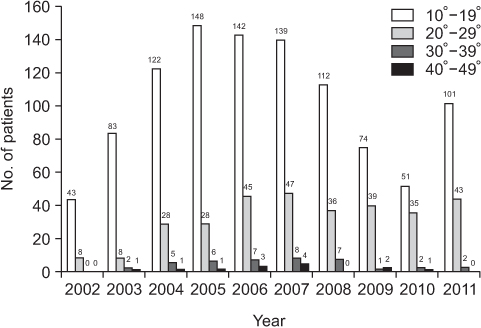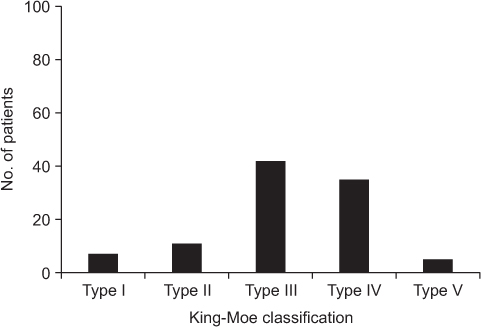J Korean Orthop Assoc.
2015 Feb;50(1):25-30. 10.4055/jkoa.2015.50.1.25.
Prevalence Study of Adolescent Idiopathic Scoliosis in Ten-, Eleven-Year Olds for 10 Years
- Affiliations
-
- 1Department of Orthopaedic Surgery, Busan Paik Hospital, Inje University College of Medicine, Busan, Korea. 97111033@hanmail.net
- 2Korea Association of Health Promotion, Busan, Korea.
- 3Department of Orthopedic Surgery, Dong-A University College of Medicine, Busan, Korea.
- 4Spine Center, Park Weon Wook Hospital, Busan, Korea.
- 5Department of Orthopaedic Surgery, Pusan National University School of Medicine, Busan, Korea.
- KMID: 2106734
- DOI: http://doi.org/10.4055/jkoa.2015.50.1.25
Abstract
- PURPOSE
School screening for adolescent idiopathic scoliosis (AIS) was conducted for 10 years and the prevalence of scoliosis as well as the size and types of curvature were investigated. The outcomes and existing research results were comparatively analyzed and the usefulness of the moire topography as a screening tool was evaluated.
MATERIALS AND METHODS
Moire topography was used in screening of 413,351 10- and 11-year-old from 2002 to 2011; simple standing entire spine x-rays of selected examinees were taken. When the Cobb angle was 10degrees or higher, the condition was deemed to be scoliosis, and the size, location, and types of curvature were recorded.
RESULTS
The average prevalence over the 10 years was 0.4% (0.3%-0.5%) and the trends in yearly prevalence did not change significantly. The ratio of boys-to-girls prevalence rates for the 10 years was 1.0:3.8. The rate of those with scoliosis whose curvature was 10degrees-19degrees, 20degrees-29degrees, and 30degrees-39degrees was 71%, 24%, and 4%, respectively. King-Moe type III accounted for the largest portion at 45%, followed by type IV at 35%, type II at 11%, type I at 7%, and type V at 5%.
CONCLUSION
The prevalence of scoliosis in the subjects was similar for the 10 years but differed from previous research results. The size, location, and types of curvature were similar to those reported in previous research. The differences in prevalence from existing research are considered to be due to the screening method used. Therefore, conduction of additional research on effective screening tests is necessary.
Keyword
MeSH Terms
Figure
Cited by 1 articles
-
Result of Multiphasic Personality Inventory among People with Scoliosis: Retrospective Cross-Sectional Analysis of Military Candidate in Korea
Seung Keun Kim, Taehyun Kim, Jeong Seok Seo, Seok Woo Moon, Tae Ho Kim, Jonggook Lee, Beomwoo Nam
J Korean Neuropsychiatr Assoc. 2017;56(4):181-185. doi: 10.4306/jknpa.2017.56.4.181.
Reference
-
1. Morrissy RT. School screening for scoliosis. Spine (Phila Pa 1976). 1999; 24:2584–2591.2. Willner S. Development of trunk asymmetries and structural scoliosis in prepuberal school children in Malmö: follow-up study of children 10-14 years of age. J Pediatr Orthop. 1984; 4:452–455.3. Weinstein SL. Adolescent idiopathic scoliosis: prevalence and natural history. Instr Course Lect. 1989; 38:115–128.4. Karachalios T, Roidis N, Papagelopoulos PJ, Karachalios GG. The efficacy of school screening for scoliosis. Orthopedics. 2000; 23:386–391. quiz 392-3.5. Morrissy RT. School screening for scoliosis. A statement of the problem. Spine (Phila Pa 1976). 1988; 13:1195–1197.6. Lee SH, Kim JH. A study on the actual conditions of scoliosis in fifth and sixth grade school children. J Korean Soc Sch Health. 1999; 12:143–148.7. Park MS, Lee CS, Kim YT, Ko SH, Eo J, Cho SD. Idiopathic scoliosis in the eleven years old: prevalence study. J Korean Orthop Assoc. 2006; 41:263–267.8. Suh SW, Hur CY, Chae IJ, et al. Idiopathic scoliosis in Korean middle school students: prevalence study. J Korean Orthop Assoc. 2001; 36:33–38.9. Suk SI, Jo JH, Choi JS, Cho HO, Lee YG. The prevalence of scoliosis junior and senior high school students, Pusan, Korea. J Korean Orthop Assoc. 1984; 19:431–435.10. Suk SI, Choi IH. The incidence of scoliosis in Korea, part II: the incidence of scoliosis in the middle and high school male students. J Korean Orthop Assoc. 1978; 13:317–323.11. Denton TE, Randall FM, Deinlein DA. The use of instant moiré photographs to reduce exposure from scoliosis radiographs. Spine (Phila Pa 1976). 1992; 17:509–512.12. Pehrsson K, Bake B, Larsson S, Nachemson A. Lung function in adult idiopathic scoliosis: a 20 year follow up. Thorax. 1991; 46:474–478.13. Pehrsson K, Larsson S, Oden A, Nachemson A. Long-term follow-up of patients with untreated scoliosis. A study of mortality, causes of death, and symptoms. Spine (Phila Pa 1976). 1992; 17:1091–1096.14. Torell G, Nordwall A, Nachemson A. The changing pattern of scoliosis treatment due to effective screening. J Bone Joint Surg Am. 1981; 63:337–341.15. Dvonch VM, Siegler AH, Cloppas CC, Bunch WH. The epidemiology of "schooliosis". J Pediatr Orthop. 1990; 10:206–207.16. Bunnell WP. Treating scoliosis. West J Med. 1989; 150:683.17. Nilsonne U, Lundgren KD. Long-term prognosis in idiopathic scoliosis. Acta Orthop Scand. 1968; 39:456–465.18. Rogala EJ, Drummond DS, Gurr J. Scoliosis: incidence and natural history. A prospective epidemiological study. J Bone Joint Surg Am. 1978; 60:173–176.19. Lonstein JE, Bjorklund S, Wanninger MH, Nelson RP. Voluntary school screening for scoliosis in Minnesota. J Bone Joint Surg Am. 1982; 64:481–488.20. Inoue M, Minami S, Kitahara H, et al. Idiopathic scoliosis in twins studied by DNA fingerprinting: the incidence and type of scoliosis. J Bone Joint Surg Br. 1998; 80:212–217.21. Laulund T, Søjbjerg JO, Hørlyck E. Moiré topography in school screening for structural scoliosis. Acta Orthop Scand. 1982; 53:765–768.22. Soucacos PN, Soucacos PK, Zacharis KC, Beris AE, Xenakis TA. School-screening for scoliosis. A prospective epidemiological study in northwestern and central Greece. J Bone Joint Surg Am. 1997; 79:1498–1503.
- Full Text Links
- Actions
-
Cited
- CITED
-
- Close
- Share
- Similar articles
-
- Idiopathic Scoliosis in the Eleven Years Old: Prevalence Study
- The Boston Brace in Adolescent Idiopathic Scoliosis
- Idiopathic Scoliosis in Korean Middle School Students: Prevalence study
- Spontaneous Rib Fracture during Boston Brace Treatment for Adolescent Idiopathic Scoliosis
- The Prevalence of Idiopathic Scoliosis in Eleven Year-Old Korean Adolescents: A 3 Year Epidemiological Study



